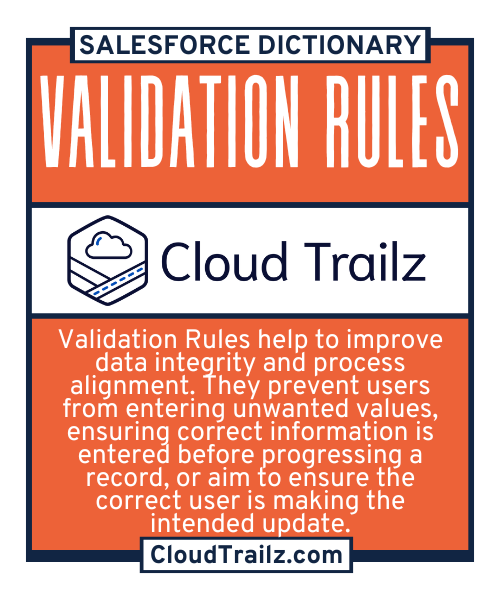
Validation Rules
Overview
Validation Rules are a type of criteria in Salesforce that allows organizations and Admins to define specific requirements and error messages at the individual record level in Salesforce. They can help further require fields or values that you aren’t able to enforce through dynamic pages or page layouts.
How Are Validation Rules Used?
Rules are defined at an Object level, they apply to individual records and are checked upon save. Validation rule criteria is defined in a failure context, meaning you write the criteria to evaluate to True, when the record SHOULD fail. With the rule you can also define the error message alerting the user to the reason for the failure.
Rules can reference field values, lookup values, user values, profile values, role values, permission values and more to define criteria.
What is the Benefit?
Error Prevention
Validation Rules allow admins to define specific scenarios in which records should not be allowed to be created/edited. In doing so, you help ensure data integrity and that business processes are followed as they should be.
User Experience
Validation Rules give insight in real time as to why an action can’t be performed against a record. They help to ensure processes are always followed and ensure that role specific actions/requirements don’t impact other roles.
Common Use Cases of Validation Rules
| Use Case Name | Role Involved | Scenario | Outcome |
|---|---|---|---|
| Enforce Selling Rules | Admins | Enforce field capture |
|
| Enforce Case Rules | Admins | Disable reverting Status |
|
Common Challenges
#1 – Validation Rule isn’t working as desired
Resolution
Unlike most formulas or scenarios, Validation Rules need to be written in the context with which they would fail, not succeed. Ensure you have structured them in the “negative” context. If writing, and not using drop down, verify you have chosen the correct syntax and merge fields.
#2 – Validation fires for system processes or Admins
Resolution
Utilize Profile and Permission merge field capabilities to exclude automated or admin users from Validation Rules as required. Same goes for any other role of user who should be excluded from certain Validations.
Who is Impacted?
End Users
These rules act as a safeguard against violating standard business practices.
Salesforce Administrators
Administrators can ensure their customers needs are met, building out the validation rules and error messages as requested from their client.